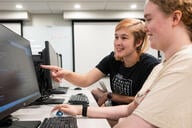You have /5 articles left.
Sign up for a free account or log in.

enot-poloskun/iStock/Getty Images Plus
I was pleased to wake up one morning last week to find Steven Mintz’s blog post for Inside Higher Ed “The F Word” awaiting me in my inbox. The piece argues forcefully for the need to place faculty at the forefront of the student success movement. Given that faculty are in charge of instruction, curriculum design and mentoring, it’s hard to imagine how we can accomplish anything like the transformation in higher education that the current focus on student success will require without faculty playing a leading role.
It would be weird for me to argue with his thesis: my entire job is to engage my faculty colleagues in activities related to student success and educational equity. I do this work at a public research university not too different from the one where Mintz teaches.
I’ve also been surprised by how slowly the conversation around student success has filtered into the faculty ranks. At many institutions, as he points out, the conversation has been directed at professional staff in areas like advising, financial aid and student affairs. Anyone tracking the movement more or less closely for the past few years would be forgiven for asking—and believe me, I get asked the question all the time by my professional staff colleagues—“but where is the faculty in all this?” We as faculty members have responsibility for a large share of the governance of academic programs and majors. You can’t solve student success challenges without professional nonacademic partners, but you surely can’t solve them without faculty, either.
So where’s the problem? The problem is the one word missing from Mintz’s analysis: the L word.
Any institution—especially a research-intensive institution—that wants to get serious about student success is going to have to take on the wicked problem of faculty labor. Enhancing student success, at least initially, necessitates increased workloads in the broad areas of teaching, learning and mentoring. Most of the conversations I have been a part of about the faculty role in student success miss this essential point: you can’t have an additive model of student success, in which the faculty just works more on teaching, mentoring and curriculum planning, while the rest of its duties remain the same.
Notwithstanding Mintz’s discussion of “incentives,” such as financial rewards for good mentoring and paying people to attend professional development seminars, you can’t stipend your way out of this problem. Workloads in higher education have been skyrocketing for the past 20 years. The pandemic taught us a lot about what happens when you suddenly ask faculty members to redirect enormous amounts of time and attention to redesigning their courses and changing their instructional practices, while leaving the rest of the expectations around their labor unchanged: morale plummets, research suffers and people decide perhaps they would like to look for other kinds of work, or work elsewhere, at another institution, where, they quickly discover, workloads are also skyrocketing. The problem is structural and cannot be fixed simply by asking individuals to “do better,” at least in part because, initially anyway, “do better” means “do more.” To put this another way, stipends are great, but they can’t buy time and time is the scarcest resource in the resource-strapped higher education world of the 21st century.
To give a few very basic examples from my own campus experience, if a group of instructors decides to significantly redesign a critical gateway course, they will need time away from other duties to engage in that activity. We can’t always give teaching relief, because that’s a kind of whack-a-mole that leaves department chairs scrambling to staff the curriculum. If institutions don’t think holistically and consistently about faculty labor, they will tend to default to solving this problem by backfilling with contingent faculty, while the full-time faculty—who control the curriculum—engages in course redesign. One of the most powerful and strategic things an institution thinking about sustainability over the long term can do is to challenge itself to work through its student success ambitions without hiring more adjuncts.
Another example would be a larger-scale redesign of an entire gateway sequence, within or across a number of departments. Great idea! But the faculty involved in these activities—hopefully supported by teaching and learning professional staff who have the research-backed expertise to advise and help them with the project—will now be unavailable for other kinds of service assignments. Why not pay them to do it in the summer? Well, the summer is when many of us really turn to our research (or, you know, take some time off from the perpetual bullet train ride of our jobs).
I applaud Mintz’s insistence that faculty members should engage with data around student outcomes, equity gaps and persistence. For most of our academic careers, we have never been asked to look backward in any comprehensive way at the performance of students in our courses over time. It’s very useful (and pretty darn interesting) to do so and there are skilled professional staff on most campuses now who can get us those data and teaching and learning center specialists who can help translate for us. But then what? Knowing that there are patterns of inequitable outcomes in your courses is one thing; knowing what to do to remedy those patterns is another. Understanding how to mitigate equity gaps takes a significant amount of expertise and involves changes in instructional practice and in course and curricular design that take (you guessed it) time.
One of the more curious statements on this topic comes early in Mintz’s piece: “I feel certain that mandating ongoing professional development in pedagogy is a nonstarter.” I see this as a terrifically shortsighted view. Having robust pedagogical preparation during a new faculty member’s early career, for instance, will pay off throughout the faculty member’s time at the university. Certainly, early-career faculty members are under great pressure to conduct research, but they also have limited service responsibilities, and many—though by no means all—receive some teaching relief in the first few years. What if there was an expectation that early-career faculty spend some of their first two years engaged in evidence-based teaching development activities and—and this one is critical—have direct support in designing their courses when they do begin to teach? I would agree that “mandated” pedagogy “training” for mid- to late-career faculty is inadvisable, but our experience has been that when faculty members feel supported early in their careers—or any time, really—they continue to ask for guidance around teaching and learning as they move through those careers. They realize that getting help may save them time in the long run. Robust early-career professional development is a labor-saving investment, for the faculty member and thus for the institution.
Perhaps the most important reason to bring a labor lens to this conversation is that the work of improving student success falls disproportionately on faculty members of color and, in some fields, on white women. These faculty members consistently spend more time mentoring, advising and supporting students than the majority of their white colleagues. Approaching student success without holistic attention to the entire spectrum of faculty labor most seriously disadvantages the very faculty members our institutions say they want to be hiring and supporting in order to produce a more racially diverse and academically outstanding professoriate. The “tax” for the new prioritization of student success cannot be highest for colleagues who are BIPOC—but far too often, it is.
At my institution, we’ve begun to shift the focus to “academic success” in an effort to ensure that student success and faculty success are not placed in opposition to each other. Taking a holistic view of academic success involves backing up far enough to appreciate that personnel processes, faculty review, tenure clocks and career stages all have to be part of the conversation for a university that wants to achieve academic excellence for all members of the institution. It involves expanding faculty roles to include teaching professors with the security of tenure or its equivalent who bring research-based expertise to inform the needed transformations in teaching and learning. It involves fundamentally rethinking how we train and reward graduate students, who, in their role as teaching assistants, are essential partners in the challenge to achieve student success at large, research-intensive universities. It probably requires (gasp) a senior administrator drawn from the faculty whose job it is to try to push the deep and significant changes in policy, practice and culture that will be necessary to achieve this elusive goal called student success in a complex environment of already overburdened laborers. And it requires abandoning the magical thinking that suggests that we can leave everything else in place and become “student-centered” universities, when so many higher education institutions were built and maintained with distinctly different priorities from the outset.




